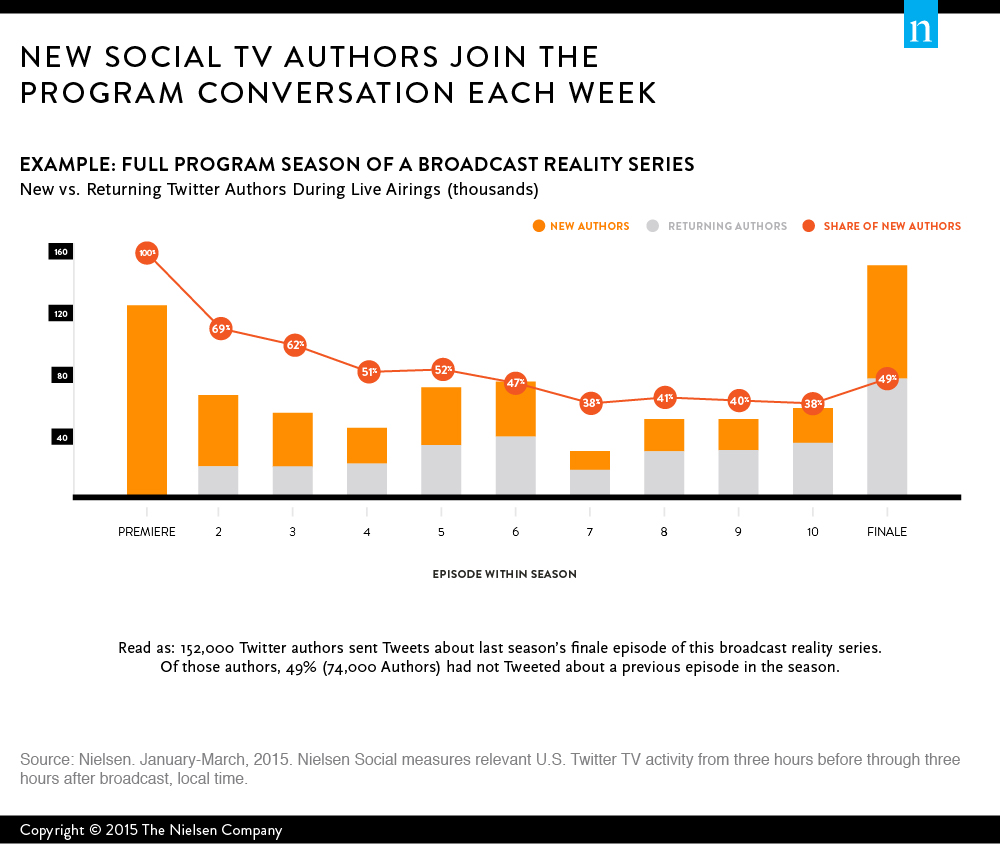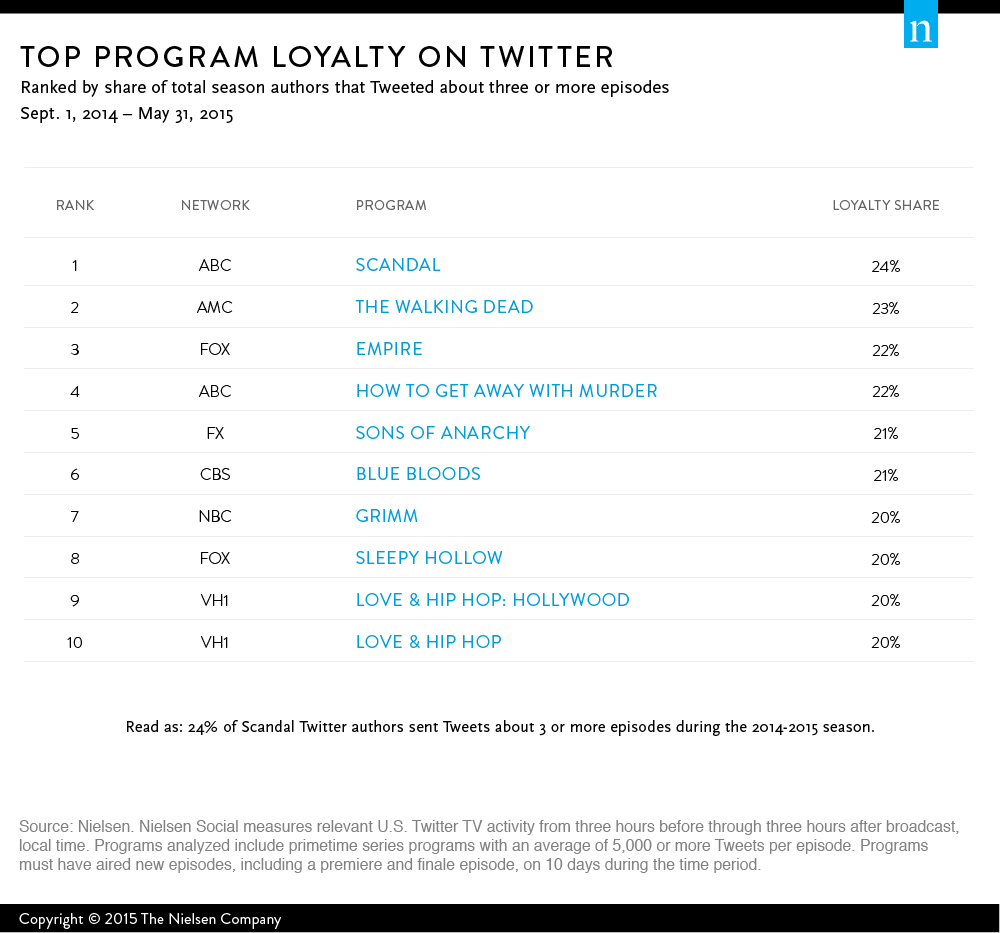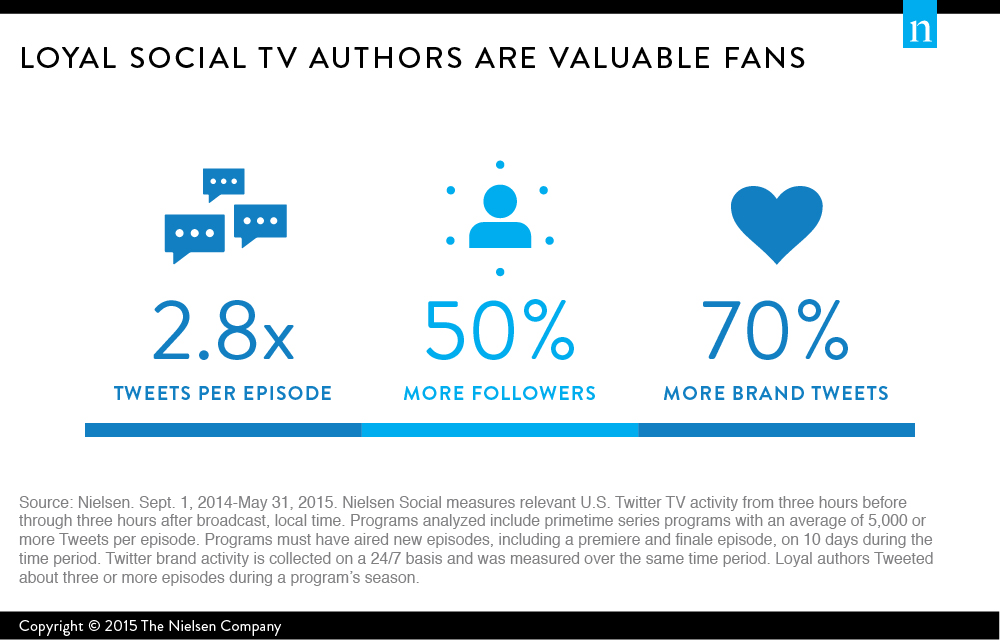Social media activity about live TV programming ebbs and flows as each program airs, signaling, according to recent research, how engaged the general audience is with what they’re watching. But when we step outside the minute-by-minute activity, we often see that individual programs see relatively steady overall levels of social activity during live airings.
With this premise in mind, Nielsen wanted to understand if the same group of authors comment each week, thus creating the steady flow of weekly program buzz. Or, alternatively, is there a larger group of audience members taking to Twitter over the course of the season, each jumping into the conversation at various moments throughout? The latter scenario would reveal that the group of “active” authors is larger than weekly activity levels would suggest. It would also indicate an opportunity for program marketers to increase how frequently they engage with individual authors during a season (e.g., via live Tweeting by owned accounts, paid social campaigns, on-screen calls to action).
To understand patterns of author engagement for primetime series programs across the recent broadcast TV season, Nielsen Social studied 113 program seasons, from premiere through finale, from September 2014-May 2015, analyzing the total number of new episodes within each program’s season that individual authors Tweeted about. The study delivered three key insights:
- New social TV authors regularly join program conversation
- Loyal authors are valuable for more than just their social allegiance
- Big program moments inspire more fans to jump into the conversation
The following sections provide more detail on these areas.
NEW AUTHORS REGULARLY JOIN PROGRAM CONVERSATION
The study found that the total number of individual Twitter authors that Tweet about a program across a season is significantly larger than the number of individuals that contribute to program-related conversation in a given week. For the programs in the study, an average of 10 times as many authors Tweeted about a program in total across a season compared with the number of authors who contributed in an average week.
So, new voices jump into the conversation throughout the season, with fans that have never posted before commenting along side others that post more frequently.

LOYAL AUTHORS ARE VALUABLE FANS
The study also revealed which programs had the most socially loyal fans during the past TV season. Social loyalty was defined as the share of authors who Tweet about three or more episodes during a season. For the top loyal programs up to 24% of authors posted with such a frequency over the course of the season.

In addition to their loyalty, program authors who Tweeted about three or more episodes also exhibited other traits that could be valuable for TV networks and advertisers. On average, these authors sent nearly 3 times as many Tweets per episode than other authors. They were also found to have more followers and sent more Tweets about brands. Identifying and cultivating relationships with loyal authors could be powerful for TV networks and advertisers as they each look to maximize earned media driven by TV content and advertising.

FANS JOIN THE CONVERSATION FOR BIG MOMENTS
Along with revealing the value in programs’ loyal authors, the study also found that there are big moments within a season when larger groups of authors jump into the conversation. For instance, on average, 25% of all program authors Tweet about premieres and 16% Tweet about finales. Between these two groups combined, networks can expect to hear from an average of 38% of program authors during those two moments.
These are moments that program marketers could take advantage of. For instance, premieres could be an opportunity to maximize early promotion for a new program. Advertisers and agencies could also use these big moments to maximize earned media from sponsorships and integrations.
The opportunity for networks to build loyalty among social TV authors and drive buzz about their programs is huge. And for advertisers and agencies, the well is deep with opportunity to leverage patterns in engagement to maximize brand-related buzz around TV placements. The three key takeaways from this study are:
- For many programs, there could be an opportunity through retention strategies (e.g., on-screen calls to action, live Tweeting by owned accounts, or paid social campaigns) to convert new authors that join the program conversation over the course of a season into loyal program authors.
- There is also value for networks and advertisers in engaging loyal program authors—those who not only Tweet more regularly throughout a program’s season, but also send more Tweets about program content and brands and have larger followerships. By closely analyzing program activity during live airings, networks and advertisers could identify and engage with these loyal and influential TV authors to maximize program-related buzz.
- Finally, the findings emphasize the importance of key moments—such as premieres, finales or other high engagement episodes. These are opportunities for programmers and advertisers to engage with more authors. Of particular note: 25% of authors Tweet about premieres on average. So, premieres could be a critical point at the beginning of a season to maximize early buzz and foster loyalty for ensuing episodes.
As industry players prepare to engage viewers this fall, these insights can be applied to more holistically understand audiences’ response to programming from week to week. Through ongoing measurement and analysis of new and returning authors—an advanced analysis available this fall from Nielsen Social—networks, agencies and advertisers can prepare to take action to amplify earned media driven by live TV content.
Methodology
Nielsen Social measures relevant U.S. Twitter TV activity from three hours before through three hours after broadcast, local time. Programs analyzed include primetime series programs with an average of 5,000 or more Tweets per episode. Programs must have aired new episodes, including a premiere and finale episode, on 10 days between Sept. 1, 2014 and May 31, 2015. Twitter brand activity is collected on a 24/7 basis and was measured over the same time period as program activity for this analysis.



